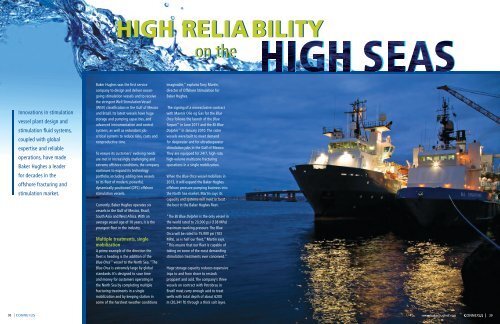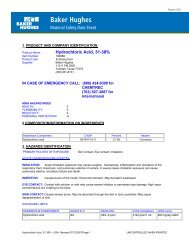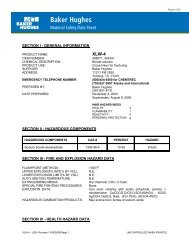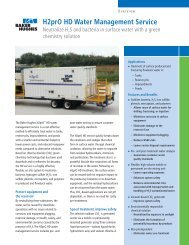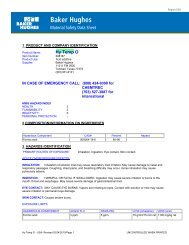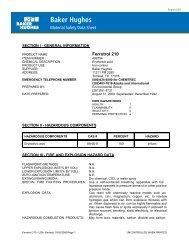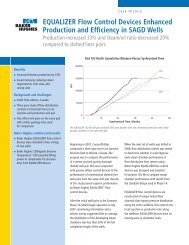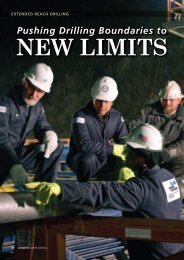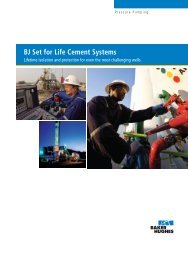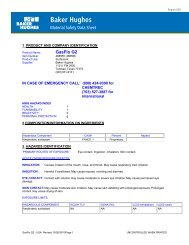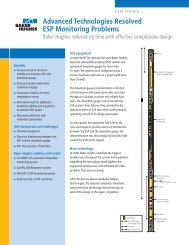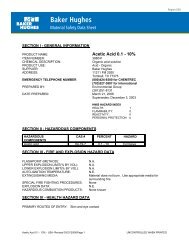high reliability
high reliability
high reliability
Create successful ePaper yourself
Turn your PDF publications into a flip-book with our unique Google optimized e-Paper software.
HIGH RELIA BILITY<br />
on the<br />
Innovations in stimulation<br />
vessel plant design and<br />
stimulation fluid systems,<br />
coupled with global<br />
expertise and reliable<br />
operations, have made<br />
Baker Hughes a leader<br />
for decades in the<br />
offshore fracturing and<br />
stimulation market.<br />
Baker Hughes was the first service<br />
company to design and deliver oceangoing<br />
stimulation vessels and to receive<br />
the stringent Well Stimulation Vessel<br />
(WSV) classification in the Gulf of Mexico<br />
and Brazil. Its latest vessels have huge<br />
storage and pumping capacities, and<br />
advanced instrumentation and control<br />
systems, as well as redundant jobcritical<br />
systems to reduce risks, costs and<br />
nonproductive time.<br />
To ensure its customers’ evolving needs<br />
are met in increasingly challenging and<br />
extreme offshore conditions, the company<br />
continues to expand its technology<br />
portfolio, including adding new vessels<br />
to its fleet of modern, powerful,<br />
dynamically positioned (DP2) offshore<br />
stimulation vessels.<br />
Currently, Baker Hughes operates six<br />
vessels in the Gulf of Mexico, Brazil,<br />
South Asia and West Africa. With an<br />
average vessel age of 10 years, it is the<br />
youngest fleet in the industry.<br />
Multiple treatments, single<br />
mobilization<br />
A prime example of the direction the<br />
fleet is heading is the addition of the<br />
Blue Orca vessel to the North Sea. “The<br />
Blue Orca is extremely large by global<br />
standards. It’s designed to save time<br />
and money for customers operating in<br />
the North Sea by completing multiple<br />
fracturing treatments in a single<br />
mobilization and by keeping station in<br />
some of the harshest weather conditions<br />
imaginable,” explains Tony Martin,<br />
director of Offshore Stimulation for<br />
Baker Hughes.<br />
The signing of a nonexclusive contract<br />
with Maersk Olie og Gas for the Blue<br />
Orca follows the launch of the Blue<br />
Tarpon in June 2011 and the BJ Blue<br />
Dolphin in January 2010. The sister<br />
vessels were built to meet demand<br />
for deepwater and for ultradeepwater<br />
stimulation jobs in the Gulf of Mexico.<br />
They are equipped for 24/7, <strong>high</strong>-rate,<br />
<strong>high</strong>-volume multizone fracturing<br />
operations in a single mobilization.<br />
When the Blue Orca vessel mobilizes in<br />
2013, it will expand the Baker Hughes<br />
offshore pressure pumping business into<br />
the North Sea market. Martin says its<br />
capacity and systems will meet or beat<br />
the best in the Baker Hughes fleet.<br />
“The BJ Blue Dolphin is the only vessel in<br />
the world rated to 20,000 psi (138 MPa)<br />
maximum working pressure. The Blue<br />
Orca will be rated to 15,000 psi (103<br />
MPa), as is half our fleet,” Martin says.<br />
“This means that our fleet is capable of<br />
taking on some of the most demanding<br />
stimulation treatments ever conceived.”<br />
Huge storage capacity reduces expensive<br />
trips to and from shore to restock<br />
proppant and acid. The company’s three<br />
vessels on contract with Petrobras in<br />
Brazil must carry enough acid to treat<br />
wells with total depth of about 6200<br />
m (20,341 ft) through a thick salt layer,<br />
38 |<br />
www.bakerhughes.com<br />
| 39
01> Full remote control and systems monitoring from the control<br />
room of the BJ Blue Angel reduce safety risks and enable<br />
secure, fast data transmission globally and wirelessly.<br />
02> The Blue Tarpon, launched in June 2011, provides fracturing,<br />
sand control, acidizing and pressure pumping with three<br />
blenders offering maximum backup.<br />
notes Luis Duque, Marketing and Engineering manager for Baker<br />
Hughes in Latin America. Acid fracs and self-diverted acid<br />
treatments are common for limestones in the pre-salt layer, while<br />
post-salt sandstone layers require propped fracs and matrix<br />
acid stimulation.<br />
“The amount of acid must cover the whole horizontal section,”<br />
Duque says. “Most of these wells are <strong>high</strong>ly deviated and the<br />
production section is as long as 2000 m [6,562 ft]. This is why we<br />
recently upgraded the BJ Blue Shark with more acid capacity.”<br />
High technology, enhanced <strong>reliability</strong><br />
All Baker Hughes vessels have strong DP2 systems with bow and<br />
stern thrusters specifically designed to keep the vessel on station<br />
in virtually any weather condition. Multiple layers of redundancy<br />
ensure that a vessel will maintain position and remain within the<br />
operating envelope.<br />
01<br />
02<br />
“During treatments, the vessel pulls up alongside the platform<br />
and connects to it with two large <strong>high</strong>-pressure hoses,” Duque<br />
says. “While they’re connected, the vessel must remain on station.<br />
We have an emergency disconnect system to use as a last resort<br />
if the vessel has to move away from the installation.”<br />
To assure operational <strong>reliability</strong>, job-critical systems in the<br />
blending and mixing process, as well as the generating power to<br />
run these systems, have full redundancy. Stimulation plant power<br />
systems run independently from the marine power systems so that<br />
pumping operations are not affected by the load on the dynamic<br />
positioning system.<br />
This full back-up, combined with Baker Hughes’ advanced<br />
instrumentation and control systems, makes fracturing and<br />
stimulation treatments reliable and easy to control.<br />
“Pumps haven’t changed much over the years, but instrumentation<br />
and controls are much more advanced now. We used to have a<br />
wall of the control room covered with a process flow diagram,<br />
switches and a panel of hundreds of valves that needed three<br />
people to run,” Martin explains.<br />
“Today, the controls look like something out of a science fiction<br />
movie. They are remotely operated by a small number of people in<br />
the control room and can even be operated from onshore. Operators<br />
can configure and control everything using touch-sensitive screens.”<br />
Baker Hughes was one of the first companies to develop remote<br />
operation of <strong>high</strong>-pressure pumping equipment, which eliminates<br />
the need for personnel to work directly with and around rotating<br />
or <strong>high</strong>-pressure equipment under normal operations. “This<br />
dramatically reduces the potential for safety-related incidents,”<br />
Martin says.<br />
In addition, Baker Hughes was the first to develop a modular,<br />
temporary installation vessel design. The StimFORCE modular<br />
stimulation system is a customized arrangement of skid-based<br />
pumping equipment that can be shipped to a location and<br />
reassembled on a platform supply vessel, barge or offshore rig.<br />
It is designed to reduce costs with an on-demand stimulation<br />
pumping solution.<br />
In-house designed, engineered<br />
Baker Hughes’ newest vessels are built on hulls as long as an<br />
American football field. Alec Glennie, International Support<br />
manager for Baker Hughes in Singapore, says the company<br />
usually modifies a standard hull and uses well-established<br />
engineering designs.<br />
“All equipment, instrumentation and software are designed in-house to<br />
provide customers with <strong>high</strong> quality and continuity. Most of the major<br />
components are built in our Pressure Pumping facility in Tomball, Texas,”<br />
Glennie says.<br />
Tomball Group Leader Stan Bradford oversees the experienced engineers,<br />
designers and draftsmen responsible for designing the vessel’s electrical,<br />
hydraulic, pneumatic and process systems. The stimulation plant his team<br />
designs will dominate the Blue Orca hull.<br />
“We will use every square inch available,” Bradford confirms. “The<br />
stimulation plant will house fracturing units, proppant and chemical injection<br />
equipment, acid systems, piping, and pumps, as well as safety, hydraulic and<br />
electrical systems. The equipment will weigh in at 500 to 700 metric tons<br />
(551 to 772 tons) in an intelligent, efficient layout that makes plant<br />
maintenance easier. It will be enclosed to protect the equipment and<br />
personnel from the elements.”<br />
In addition to the Tomball team, Baker Hughes will supervise engineering at<br />
the shipyard during the Blue Orca’s construction, Bradford says, “We don’t<br />
rely on third parties. That is how we ensure that the end product is what our<br />
clients need.<br />
“All our latest vessels also have WSV classification, which means they meet<br />
the <strong>high</strong>est criteria available for dependability, quality and safety, every time.”<br />
The vessels are class certified by internationally recognized classification<br />
societies, and ISO 9000 certified for quality-management systems. They<br />
comply with International Safety Management (ISM) Code to ensure safety<br />
at sea, to prevent human injury or loss of life and to avoid damage to the<br />
environment and to the vessel.<br />
Designs keep pace with advancements in chemical processes, quality and<br />
engineering, and increasing regulations, Glennie adds. The engines powering<br />
the vessels and stimulation plants meet all current environmental standards<br />
for reduction of pollutants such as oxides of nitrogen and sulphur, and<br />
greenhouse gasses, particularly carbon dioxide. Material that cannot be<br />
discharged is stored on board so it can later be disposed of correctly on shore.<br />
The last five years have seen a sharp increase in offshore drilling activity,<br />
especially in areas that have traditionally been significant stimulation markets,<br />
such as the North Sea and Brazil. This has produced a corresponding increase<br />
for demand in stimulation vessels, and this boom is expected to continue for<br />
the foreseeable future. “While Baker Hughes has the youngest stimulation<br />
fleet in the business, many of the industry’s vessels are aging and due for<br />
retirement,” Martin says. “These two factors mean that demand for offshore<br />
stimulation will probably outstrip supply in a couple of years without a<br />
significant investment in infrastructure. Baker Hughes is already doing this<br />
and is posed to lead the industry through the next decade.”<br />
A Steady Presence in Rough Waters<br />
Very large fracturing treatments and a harsh<br />
working environment are driving the design of the<br />
Blue Orca , the seventh offshore stimulation vessel in<br />
the Baker Hughes fleet.<br />
The company won the tender to design, build and<br />
commission a new stimulation vessel and to supply<br />
proppant fracturing, acid fracturing and matrix<br />
acidizing services for Maersk Olie og Gas in the<br />
Danish sector of the North Sea. Baker Hughes was<br />
chosen based in part for its extensive experience<br />
mobilizing and operating offshore fracturing<br />
vessels, its experienced mechanical engineering and<br />
instrumentation teams, and its successful ongoing<br />
contracts with Maersk for completions, directional<br />
drilling and wireline services.<br />
To meet Maersk’s requirements, the Blue Orca will<br />
be one of the <strong>high</strong>est-capacity vessels in the world.<br />
Baker Hughes Offshore Stimulation Director Tony<br />
Martin explains that the operating conditions in the<br />
North Sea demand a lot of raw material storage and<br />
pumping capacity to do multiple treatments without<br />
returning to port.<br />
“The Blue Orca will have above-deck storage for 1<br />
million pounds of material for use on the job, the<br />
largest proppant capacity in the fleet. Hydrochloric<br />
acid capacity of 190,000 gallons will equal that of<br />
our largest vessels,” Martin says. “Also, there will be<br />
bulk tank storage for an additional 1.4 million pounds<br />
below decks. At 15,000 HHP, the Blue Orca’s hydraulic<br />
horsepower will rank third in the fleet.”<br />
At 311 ft (95 m), the purpose-built hull is under<br />
construction at an Edison Chouest shipyard in<br />
Louisiana. It will have extra structural strength to<br />
support the stimulation plant and materials, says<br />
Singapore International Support Manager Alec<br />
Glennie. “It will need a robust ballast system because<br />
we will be pumping at <strong>high</strong> rates at sea and must<br />
be able to counter the movement of the center of<br />
gravity,” he says.<br />
Glennie describes the Blue Orca as a “clean” vessel<br />
that will collect fluids instead of discharging them<br />
overboard and will use only chemicals that are<br />
approved for the North Sea environment.<br />
“With the Blue Orca, Baker Hughes will continue<br />
to uphold our commitment to provide world-class<br />
deepwater stimulation vessels to the major offshore<br />
basins around the world,” adds Lindsay Link,<br />
president of Pressure Pumping for Baker Hughes.<br />
The target completion date in mid-2013 gives<br />
Baker Hughes an opportunity to service other<br />
customers with the vessel before the Maersk contract<br />
starts in October 2013.<br />
40 |<br />
www.bakerhughes.com<br />
| 41


